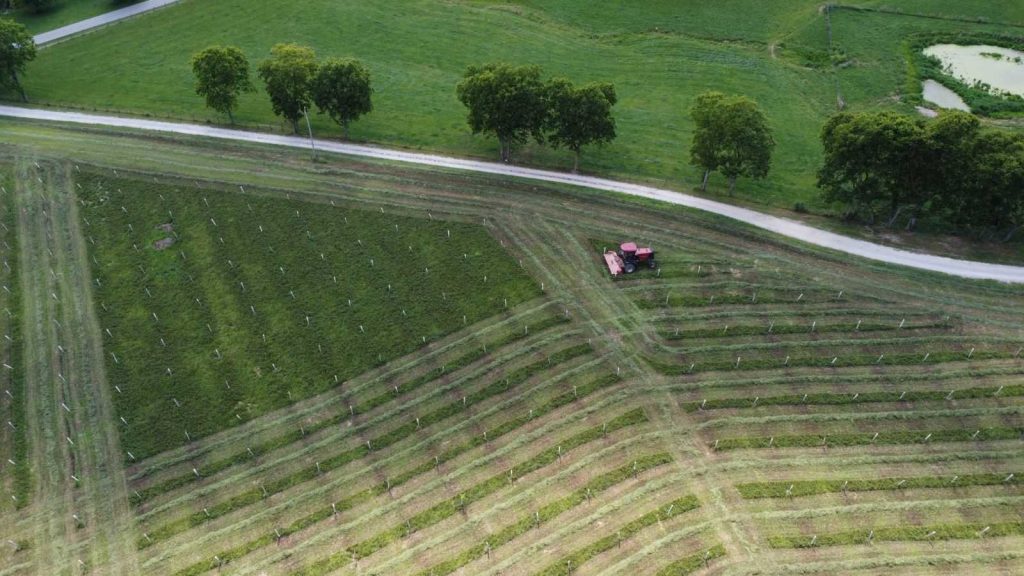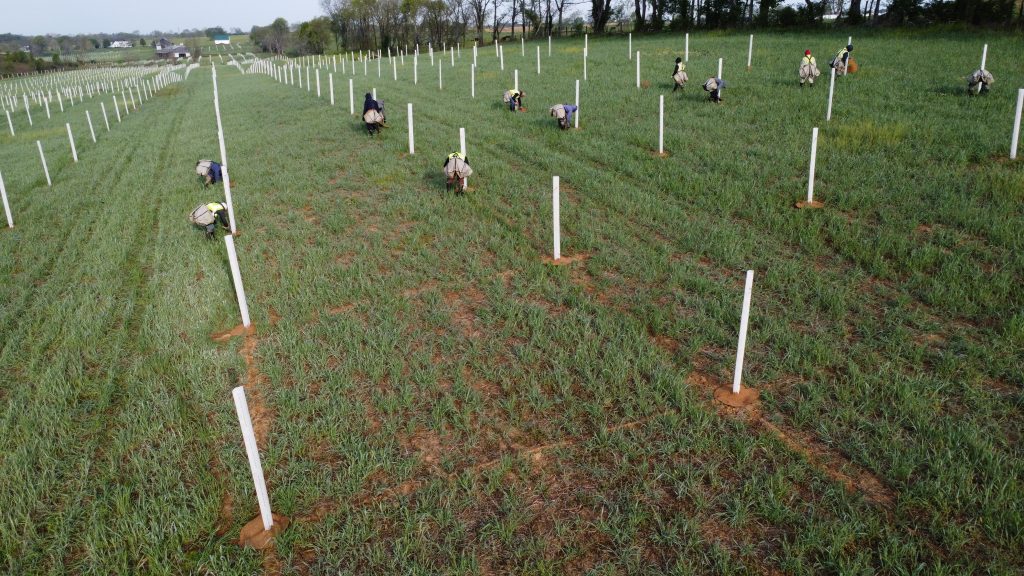For more than three decades, Keavin Hill has managed corn, soy, and wheat across approximately 4,000 acres of farmland that covers parts of both southern Ohio and Northern Kentucky. But today these properties are starting to look a little different. This past summer Hill Farms added 51,000 chestnut trees across 650 of their acres. This massive transition in land use to include permanent crops is set to bring both long-term ecosystem and economic benefits to Hill’s operation and he’s not alone. Hill is one of a growing number of operators that are adopting agroforestry – defined as the intentional integration of trees and shrubs into crop and animal farming systems. It’s not just operators either, investors are also slowly turning onto the opportunity of agroforestry…with good reason.
Benefits of Agroforestry
When properly managed, agroforestry can work to increase a farm’s profitability and environmental stability. The integration of fruit, nut, and timber crops into monoculture farming systems can lead to increased revenue potential through diversification of revenue streams. This diversification in crops and revenue is important to operators like Hill both for overall profitability and risk mitigation. Hill explains, “I have always been open to new practices and trends which allow for diversification of operations. A farm operation that lacks the flexibility to adapt to influential internal variables and external market factors is sacrificing revenue and growth potential.” With the addition of tree crops, his operation gains some of this flexibility.
Specific agroforestry strategies – like alley cropping, silvopasture, windbreaks, and riparian buffers – can also improve the farming ecosystem, making it more productive and creating opportunities to cut external input costs for things like water, fertilizer, and pesticides. For example, trees can help reduce erosion – something that’s causing the loss of 10 tons of soil per hectare per year and with it, soil nutrients. As soil erosion is reduced, nutrient retention is increased – building healthier soils and potentially lowering the need for external nitrogen and phosphorus inputs. Other environmental benefits include improving water quality and enhancing biodiversity.
Trees also help address climate change because, as they grow, they draw carbon out of the atmosphere and store it in the tissue of their new growth. In fact, in one year, a healthy, mature tree can draw down approximately 48 pounds of carbon dioxide and store it permanently. The inclusion of tree crops in one’s farming system, then, has an imminent positive impact on climate mitigation. So much so that Project Drawdown – a leading resource for climate solutions – says agroforestry is among the best natural climate solutions and ranked silvopasture – which integrates trees, pasture, and forage into a single system – as the 9th most impactful climate change solution in the world. This tremendous benefit of agroforestry means that carbon payments – and eventually payments for other services like biodiversity – may also play a role in the positive financial outcomes of agroforestry.
These new revenue opportunities and potential cost savings can drive increased profitability. Some, including regenerative agriculture expert Ernst Götsch, estimate agroforestry systems could be as much as eight times more profitable than conventional systems and other research confirms increases in profitability on farms in Bolivia, India, and Tanzania – all as a result of agroforestry.
As awareness of these economic, environmental and climate benefits increases, it’s no wonder interest in agroforestry is growing.
But still, adoption in the U.S. is limited by challenges.

Overcoming Barriers
Despite the fact that agroforestry has been around for centuries, adoption of these practices remains exceptionally low in the U.S., representing less than 1% of agriculture. This is in large part because of lack of awareness of the benefits, lack of technical know-how for on-farm planning and implementation, and initial start-up costs.
A focus on predominantly conventional monoculture systems across the U.S. for the past 50+ years, means there is little understanding of the potential benefits of agroforestry and this in-turn leads to limited experience in and understanding about how to implement these systems on farms. Brett Hundley, President of Agroforestry Partners, explains, “For most of American history, we’ve been focused on crop yields and production as the determining factor for success when it comes to meeting the needs of a growing population at home and abroad. For a large agricultural producer like the U.S., this has meant the clear cutting of land and planting of staple monocrops.” Today, switching back to a diversified perennial system, means relearning how to do a great deal of what we tried so hard not to do in recent history.
From a financial standpoint, there are barriers to adoption due to both a significant start-up cost to purchasing new tree crops and because there is a delay in return on investment, as most tree crops take multiple years to start to produce.
“Designing and implementing agroforestry projects is a large expense, despite the long-term returns and improvements in farm resilience. Farms typically operate on slim profit margins, and cannot provide the capital on their own. This represents a flaw in our industry. We need more mechanisms to activate capital from outside sources to fill the financial gap for design and implementation so that we can all harness the benefits of regenerative practices,” says Ethan Steinberg, co-founder and CEO of Propagate, a software, development and financing ecosystem that is leading the development of the industry here in the U.S.
There’s a growing community of organizations chipping away at the lack of awareness about agroforestry and its potential for application to U.S. farming systems. Organizations like Savanna Institute – which is working to grow awareness of and build coalitions around agroforestry – as well as an increasing number of project managers, like Canopy Farm Management, Cranmoor, and Working Trees that are bringing increased attention and accessibility to agroforestry. But it is Propagate that has led the system’s development for the past six years.
With Propagate’s support, Hill Farms and many other operations across the United States have been able to overcome these barriers and apply agroforestry systems at scale to their farming operations. Propagate’s winning approach is to simultaneously support farmers with project planning, implementation and technical assistance, and financing.
Project Planning
The first step for Hill and others is for the team at Propagate to evaluate the producers’ land for its current revenue generation and its potential revenue generation if tree crops were added. Propagate used their software, Overyield, to identify the best location on Hill’s first 130 acres for the tree crop based on soil quality, slope, and wetness.

Project Implementation and Technical Assistance
Technical expertise to both implement and manage agroforestry operations is another service that Propagate offers to ease the barriers of transition. For Hill, these two steps meant that the Propagate team helped create both a planting and cultivation strategy, as well as plans for operations and maintenance – all of which align with both ecological and financial goals for the operation. And in 2022, the team started planting chestnut trees.
Finance
Along with the operational assistance, Propagate – through its new Agroforestry Partners arm – enables financial institutions to engage in regenerative agriculture by providing the funding to support farms as they overcome transition hurdles. Brett Hundley, President of Agroforestry Partners, explains, “Farmers are not the bottleneck when it comes to the implementation of agroforestry. Many farmers in our network want to plant trees and repair their land. However, the funding still isn’t quite there. Financing for these projects continues to be the bottleneck.”
In Hill’s case, Agroforestry Partners set up a 20-year lease that includes the ownership of the trees as assets on the land using a combination of timber rights and farm product rights. Hundley says that “aside from the lease payments that we make to farmers, producers also benefit from the positive impacts of perennial trees and their roots on soil health, water quality, and biodiversity/pollination.” For his operation, Hill earns on stable lease payments, services for the management of the chestnut system through his agricultural management company and on alley-cropped hay for a wholly owned hay enterprise.
The increasing community of agroforestry production support organizations – including Propagate with their ecosystem of essential transition services – are making strides in increasing acreage under agroforestry management across the U.S. Propagate alone has planted a total of 180,000 trees in the past 4 years across 2,400 acres, and enabled agroforestry analysis for 1250 farm plans in Overyield. However, it is this last piece – the financial piece – that holds significant untapped potential.

The Critical Role of Investment Capital
Capital is a critical piece to the agroforestry expansion puzzle because it can help de-risk the transition for farmers adopting new practices, while leading to long-term financial upside for both farmers and funders. The same factors that make agroforestry a good bet for farmers, including that the sector is poised for growth, also make it a good investment opportunity, according to Propagate. In addition, investors can appreciate that there is low market volatility, and an expectation of stable returns.
Awareness among investors of agroforestry as an investment opportunity – much like all of regenerative agriculture – has been relatively low, so efforts to raise awareness among investors is also key. But there are signs of this changing. RFSI, for example, polled 100 attendees at the 2023 RFSI Forum about interest in investing in agroforestry. A surprising 52% said they would be interested in investing in agroforestry, and another 33% said they “may be” interested, while only 15% said no they would not be interested.
Recognizing the need for more agroforestry as a solution to many systemic problems and also understanding the agronomic and financial opportunity, in 2022 Propagate joined forces with Walnut Level Capital to launch Agroforestry Partners, the third leg of the Propagate ecosystem dedicated to financing farmers’ transition to agroforestry. As an investment fund, Agroforestry Partners raises money from long-term investors and then pays farmers to implement trees on their farms alongside crops and/or animals.
Hundley explains that “Nature is becoming a popular investment category in the U.S. as society works to offset its negative impact on the environment and mitigate or adapt to anticipated effects from climate change. When stakeholders evaluate different investment opportunities across the nature spectrum, agroforestry is standing out for its ability to provide many co-benefits under one investment.” He adds that because there is so much potential for impact in this work, they are seeing a wide range of investors interested in agroforestry. This includes impact investment funds associated with family offices, foundations, and endowments, together with corporations, private equity funds, and real asset managers.
Moreover, Hundley says that investors in their fund “are able to triple or quadruple their original investment as future cash flows are realized from selling fruits and nuts off these trees,” and he adds that there will be opportunities to sell carbon offsets related to their projects, as well. At the same time, investors can rest assured that their capital is contributing to restoring soil fertility, mitigating global climate change, and curbing negative outputs.
In this way, investors hold the key to both driving agroforestry sector growth by providing capital (and therefore resources) to farmers in transition AND sharing in the financial rewards that agroforestry can bring to the system. The kicker? There just aren’t enough agroforestry investors…yet. But Hundley assures us, “If we had $100 million tomorrow, we could put it all to work.”
Are you a farmer or investor who wants to get involved with agroforestry? Learn more about agroforestry and Propagate here.
Sarah Day Levesque is Managing Director at RFSI & Editor of RFSI News. She can be reached here.
